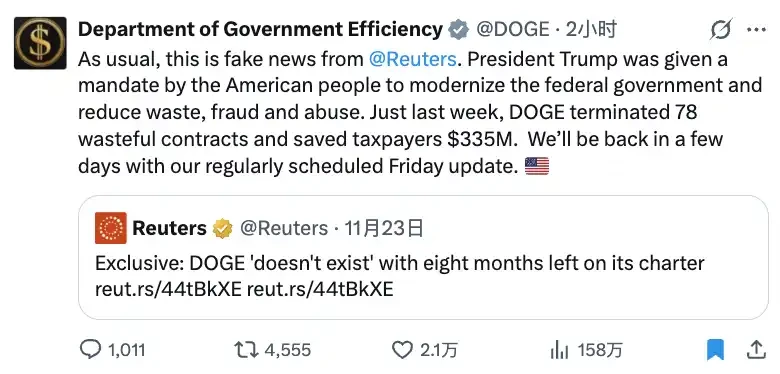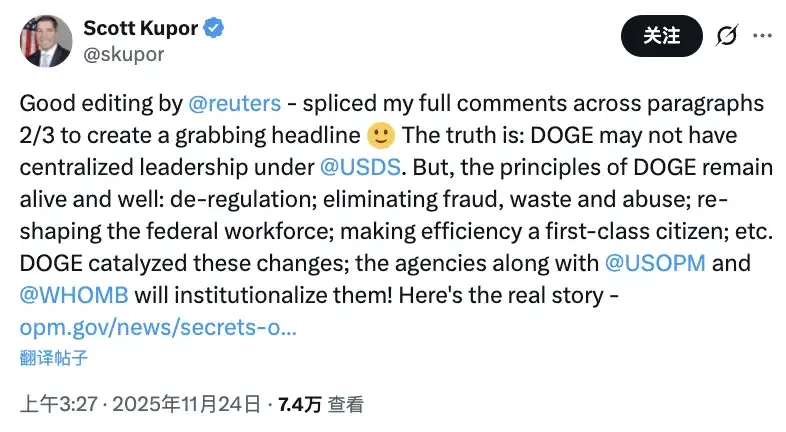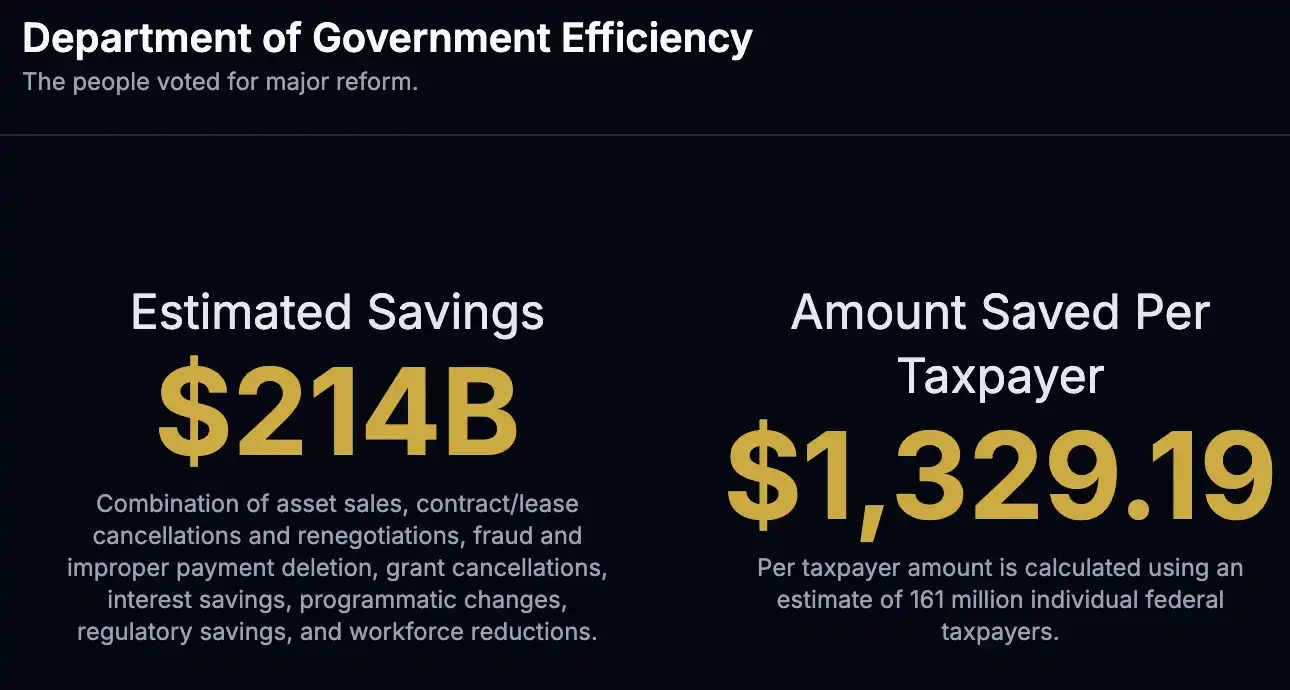From fake news to real confrontation: Why do some people always want DOGE to disappear?
The Reuters report that "the U.S. government's efficiency department DOGE has been disbanded" is actually fake news.
According to a Reuters report on November 23, the news was publicly confirmed by Scott Kupor, a senior official in the Trump administration and director of the U.S. Office of Personnel Management (USOPM). This news quickly caused a huge uproar. In Reuters' description, DOGE's gradual demise stands in stark contrast to the government's months-long campaign touting its success: Trump and his advisors, cabinet ministers, and others initially promoted it on social media, with Musk even brandishing a chainsaw to advocate for cutting government positions.
However, a dramatic turn of events soon unfolded, and this seemingly explosive report quickly sparked controversy and numerous clarifications from various parties.

DOGE tweeted that this was fake news.
Following the publication of the report, Scott Kupor, who claimed to have confirmed the information, quickly raised objections to Reuters on social media, saying that Reuters had "cleverly edited" his full commentary to create an eye-catching headline.
He clarified in a tweet: "DOGE's principles remain and function well: deregulation, eliminating fraud, waste, and abuse, reshaping the federal workforce, and making efficiency a top priority. DOGE has catalyzed these changes."; "The fact is: DOGE may not have achieved centralized leadership under @USDS. But DOGE's principles remain and are effective."

Reuters' "fake news" and the relentless calls for DOGE's dissolution have never stopped.
As a globally renowned news agency with clients all over the world, Reuters should theoretically maintain a relatively neutral stance. However, in the United States, conservative readers generally perceive Reuters as left-leaning. This preemptive report on the dissolution of DOGE raises questions: was it an objective statement of facts, or did it reflect a particular bias? This has sparked much debate.
Judging from various indications, this report may reflect several aspects: First, the establishment and traditional media are deeply unhappy with DOGE, this disruptor, and want to weaken its influence by exaggerating its "dissolution"; second, the Washington political circle is already disgusted with Musk and DOGE, and is taking the opportunity to announce its failure through the media.
This speculation among the public is not unfounded.
From its inception, the DOGE was destined to make enemies on all sides. The very existence of this institution was a challenge to the power structure in Washington, and it touched the interests of too many people, thus encountering fierce opposition from many quarters.
Protesters gathered outside the Office of Personnel Management, claiming Musk had illegally taken control of government infrastructure and fearing the unelected foreign-born individual might steal sensitive information stored on federal servers. Federal employees, retirees, and others shocked and angered by Musk and DOGE's actions organized a rally in front of the Treasury Department. Twenty-one US Digital Services (USDS) employees resigned en masse. These internal acts of resistance demonstrate the strong backlash from government employees against DOGE's aggressive practices.
Multiple polls show that a majority of Americans oppose the DOGE's dissection of government and the power Musk has gained. Musk once stated at a cabinet meeting that his team at the Department of Government Efficiency receives death threats daily.

Although Musk left Washington after publicly clashing with Trump in May, and Trump administration officials have never publicly declared that DOGE no longer exists, signals of its demise have been circulating and discussed.
For example, Scott Kupor, the "fake whistleblower" in this case, although there is no direct evidence that he has had a public conflict with Musk or DOGE, Scott Kupor has publicly stated that he does not agree with DOGE's handling of the situation.
Who is the "whistleblower" Scott Kupor?
The name Scott Kupor may be unfamiliar to many. However, he was previously the managing partner of Andreessen Horowitz (a16z), a prominent Silicon Valley venture capital firm. On July 14, 2025, Scott Kupor was sworn in as the Director of the U.S. Office of Personnel Management.
After taking office, Kupor introduced modern hiring reforms, such as changing the traditional "choose one from three candidates" to "choose from a larger talent pool," aiming to select people from a broader pool of talent. He also emphasized that OPM should become more efficient and transparent, actively bringing in technical talent (especially AI-related talent) to the federal government.
In a media interview, Kupor clearly stated, "OPM is my own organization." He added that he was willing to cooperate if DOGE's goals aligned with his, but he would never completely follow DOGE's lead. In other words, he wanted to institutionalize efficiency reforms, but would not fully accept Musk's radical approach.
Past reports also show that Kupor and DOGE have differing opinions. According to the Financial Times, he criticized the control mechanisms Musk pushed for, such as requiring employees to submit "weekly progress reports." The Washington Post also reported that he felt Musk's "5-point weekly report system" was inefficient. He also expressed skepticism about Musk's initial ultra-aggressive cuts: "We can't save two trillion dollars just by cutting discretionary spending to zero."
This gradual approach to reform contrasts sharply with Musk's aggressive layoffs. Kupor may believe that driving reform through traditional institutions like OPM is more prudent and sustainable than relying on "external advisors" like Musk. While there has been criticism, he also acknowledges that DOGE played a key catalytic role.
According to Kupor himself, and coupled with Reuters' report, OPM has now taken over much of DOGE's cost-cutting and layoff work. From a bureaucratic perspective, OPM, as the federal government's human resources department, is naturally expected to handle these tasks. Kupor's statement may reflect a shift in the Trump administration's thinking: no longer needing a controversial independent agency led by Musk, but rather integrating reform functions into regular government departments. This would allow for continued reform while reducing external pressure.
What kind of "report card" did DOGE submit?
Last October, at a Trump campaign rally at Madison Square Garden, Musk said he believed the DOGE could cut "at least" $2 trillion in federal spending, a figure higher than the discretionary spending budget for 2023.
At the first cabinet meeting in February, Musk remained optimistic that $1 trillion could be cut—15% of the budget.
However, this goal has been repeatedly scaled back over time. In April 2025, Musk stated that $150 billion had been cut, but this figure was questioned by fact-checkers. On June 5, Blake Moore, head of the House DOGE caucus, said that Republican members always knew it was a "massive exaggeration."
According to its website, DOGE terminated 13,440 contracts, 15,887 grants, and 264 leases—estimates that fluctuated wildly during its 10-month existence. DOGE pledged to save American taxpayers $1 trillion, but even according to its own accounts, it has fallen far short of that goal.
As of the time of writing, the DOGE website claims that the division has achieved $214 billion in savings through "asset sales, contract/lease cancellation and renegotiation, fraud and improper payment removal, grant cancellation, interest savings, project changes, regulatory savings, and layoffs," equivalent to $1,329.19 per taxpayer.

This figure falls far short of the initially promised $1 trillion target, representing only about 21%. Because the agency does not publicly disclose detailed operating accounts, external financial experts cannot verify the veracity of this claim. In October, after the fiscal year ended, The New York Times reported that budget experts and the Congressional Appropriations Committee still did not know how much funding had been cut or where the unused funds had gone.
In a recent tweet, DOGE stated that in the past nine days, they terminated or reduced 78 wasteful contracts, totaling $1.9 billion, saving $335 million.

These include a $616,000 HHS IT services contract for "social media monitoring platform subscriptions"; a $191,000 USAGM broadcast contract for "broadcast operations and maintenance in Ethiopia, Africa"; and a $4.3 million IRS IT services contract for "inflation reduction bill transformation project management support".
Prior to this, DOGE's "achievements" were mainly reflected in staff reductions and crippled institutions.
DOGE began its federal agency reduction efforts by eliminating employees in all federal agencies who were engaged in diversity, fairness, and inclusion work, and these individuals were placed on administrative leave.
Then, DOGE announced a voluntary "deferred retirement" program, also known as "Fork in the Road," offering federal employees the option to resign and continue receiving their salaries until the end of September—nearly 75,000 federal employees accepted this offer in February. Related reading: " Having cut hundreds of millions of dollars in contracts again, what other bizarre government departments has Musk's DOGE discovered? "
The second Trump administration announced approximately 300,000 layoffs of U.S. federal employees, almost all attributable to DOGE. As of July 14, 2025, CNN tracked at least 128,709 workers who were laid off or targeted for layoffs. As of May 12, The New York Times tracked over 58,500 confirmed cuts, over 76,000 employee buyouts, and over 149,000 other planned cuts; the total number of cuts represents 12% of the 2.4 million civilian federal workers.
In a blog post on federal staffing plans published Friday, Kupor stated that the government hired approximately 68,000 people this year, while 317,000 employees left the government—exceeding Trump's goal of cutting four people for every one hired.
Specifically, across departments: the Department of Education will cut nearly 50% of its staff. More than 1,300 positions will be eliminated through the RIF—plus approximately 600 people who accepted the "Fork" deferred resignation offer or the department's VSIP offer. The Department of Veterans Affairs aims to "restore our final strength to 399,957 employees as we had in 2019," which will reduce staff by approximately 80,000. The Department of Health and Human Services announced significant cuts, stating its intention to eliminate 20,000 positions (25% of the agency), half of which they intend to achieve through early retirement, buyouts, and attrition.
DOGE is also a driving force behind many staff reductions within the federal government this year. Government agencies account for the majority of these layoffs, with 62,530 federal workers laid off in the first two months of 2025. This is a staggering 41,311% increase compared to the same period in 2024.
It's no wonder that this fake news about the "dissolution" of DOGE has surfaced, because so many people want to see this institution that has shaken up the power structure in Washington disappear.
But now, DOGE's story may not be truly over yet.
- 核心观点:路透社DOGE解散报道为假新闻。
- 关键要素:
- 爆料人Kupor澄清报道断章取义。
- DOGE官方发推否认解散传闻。
- 报道引发对媒体立场倾向性质疑。
- 市场影响:加剧对政府机构改革关注度。
- 时效性标注:短期影响



